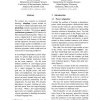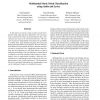153 search results - page 13 / 31 » Better Informed Training of Latent Syntactic Features |
EMNLP
2009
13 years 5 months ago
2009
We connect two scenarios in structured learning: adapting a parser trained on one corpus to another annotation style, and projecting syntactic annotations from one language to ano...
IALP
2010
13 years 2 months ago
2010
Target phrase selection, a crucial component of the state-of-the-art phrase-based statistical machine translation (PBSMT) model, plays a key role in generating accurate translation...
ACL
2000
13 years 8 months ago
2000
e, the system labels constituents with either abstract semantic roles such as AGENT or PATIENT, or more domain-specific semantic roles such as SPEAKER, MESSAGE, and TOPIC. The syst...
ICMLA
2008
13 years 9 months ago
2008
In this paper we present a study on music mood classification using audio and lyrics information. The mood of a song is expressed by means of musical features but a relevant part ...
LREC
2008
13 years 9 months ago
2008
Morphologically rich languages pose a challenge to the annotators of treebanks with respect to the status of orthographic (spacedelimited) words in the syntactic parse trees. In s...


